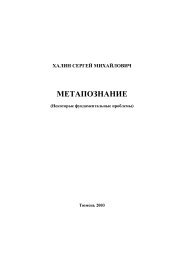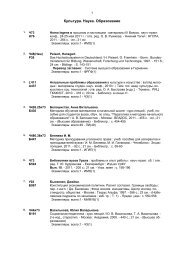The Economic History of Byzantium - Dumbarton Oaks
The Economic History of Byzantium - Dumbarton Oaks
The Economic History of Byzantium - Dumbarton Oaks
You also want an ePaper? Increase the reach of your titles
YUMPU automatically turns print PDFs into web optimized ePapers that Google loves.
1002 NICOLAS OIKONOMIDES<br />
than the pakton (for he was partially protected against a poor harvest and did not need<br />
to find cash to pay the rent in money); at the same time, the morte system must have<br />
yielded more to the landlord than did cash rents. In what follows, I consider that for<br />
the middle Byzantine period it is probable that the average yield was 4–5 parts <strong>of</strong> crop<br />
for each part <strong>of</strong> seed on high-quality land. 75<br />
Given the above particulars, one can propose the following distribution <strong>of</strong> the landowner’s<br />
income: on the basis <strong>of</strong> the Miletos praktikon <strong>of</strong> 1073, the pakton that the landowner<br />
collected from his tenants corresponded to one-tenth ( 12 ⁄120) <strong>of</strong>the value <strong>of</strong> the<br />
land he rented to them. This sum was broken down as follows:<br />
2 ⁄120 (approx.): management costs<br />
5 ⁄120: landtax( 1 ⁄24 <strong>of</strong> the value)<br />
1 ⁄120 (approx.): accretions<br />
4 ⁄120 (approx.): the landowner’s income after tax<br />
It must have been a similar distribution <strong>of</strong> income that Eustathios Boilas had in mind<br />
when herecorded inhis will (1059) the value <strong>of</strong> the land he was leaving to his two<br />
daughters and the income that each could expect after the payment <strong>of</strong> tax: (1) Estate<br />
A—value, 2,160 nomismata (plus grazing ground <strong>of</strong> unknown value); income, 80 nomismata.<br />
Bearing in mind the form <strong>of</strong> calculation proposed above, the pakton would have<br />
been 216 nomismata, broken down as follows: 36 nomismata management costs, 90 nomismata<br />
land tax, 13 1 ⁄3 1 ⁄24 nomismata accretions, in accordance with the Palaia Logarike.<br />
This leaves a net pakton <strong>of</strong> 76 15 ⁄24 nomismata, to which we have to add 3 9 ⁄24 nomismata<br />
from theennomion <strong>of</strong> the grazing land (not included in our calculation because<br />
the figures are deficient), to reach the 80 nomismata referred to by Boilas. (2) Estate<br />
B—value, 1,440 nomismata; income, 50 nomismata. Using the same formula, the pakton<br />
would have been 144 nomismata, broken down as follows: 24 nomismata management<br />
costs, 60 nomismata land tax, and 10 1 ⁄4 nomismata accretions under the Palaia<br />
Logarike, leaving 49 3 ⁄4 nomismata, which Boilas presumably rounded up to 50. 76<br />
In order to make clear the consequences <strong>of</strong> land taxation for the average taxpayer,<br />
take the imaginary example <strong>of</strong> an estate consisting <strong>of</strong> 360 modioi <strong>of</strong> first-class land in<br />
western Asia Minor, on which wheat was the sole crop. Such monocultures may not<br />
have existed at that time, but an approach <strong>of</strong> this kind facilitates the calculations by<br />
eliminating the incalculable income from intensive crops. In any case, the calculations<br />
proposed below are <strong>of</strong> statistical interest only.<br />
75 This estimate is based on certain data that, although not absolutely certain, seem to <strong>of</strong>fer considerable<br />
verisimilitude. For example, I believe that since the vita <strong>of</strong> St. Nicholas <strong>of</strong> Sion relates that by<br />
the intervention <strong>of</strong> the saint the harvest on a piece <strong>of</strong> land was five times the seed sown, then a yield<br />
<strong>of</strong> 1:5 must have been considered high. However, there are other accounts that refer to higher yields<br />
in other areas, leading Lefort (“Rural Economy,” 301) to give a grain yield <strong>of</strong> 1:5.6. Since we lack any<br />
extensive references in the sources, we are compelled to rely on estimates; there is no way <strong>of</strong> proving<br />
what the real yield <strong>of</strong> even one planting <strong>of</strong> wheat in <strong>Byzantium</strong> may have been, far less what the<br />
average yield (<strong>of</strong> interest to us here) was. However, all the calculations we propose are based on assessments<br />
<strong>of</strong> productivity that may differ, and those differences will have a corresponding effect on<br />
our estimates <strong>of</strong> the standards <strong>of</strong> living <strong>of</strong> villagers.<br />
76 Cf. Oikonomides, Fiscalité, 126–27.








